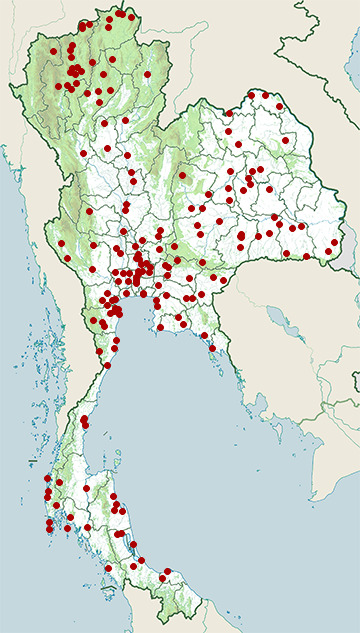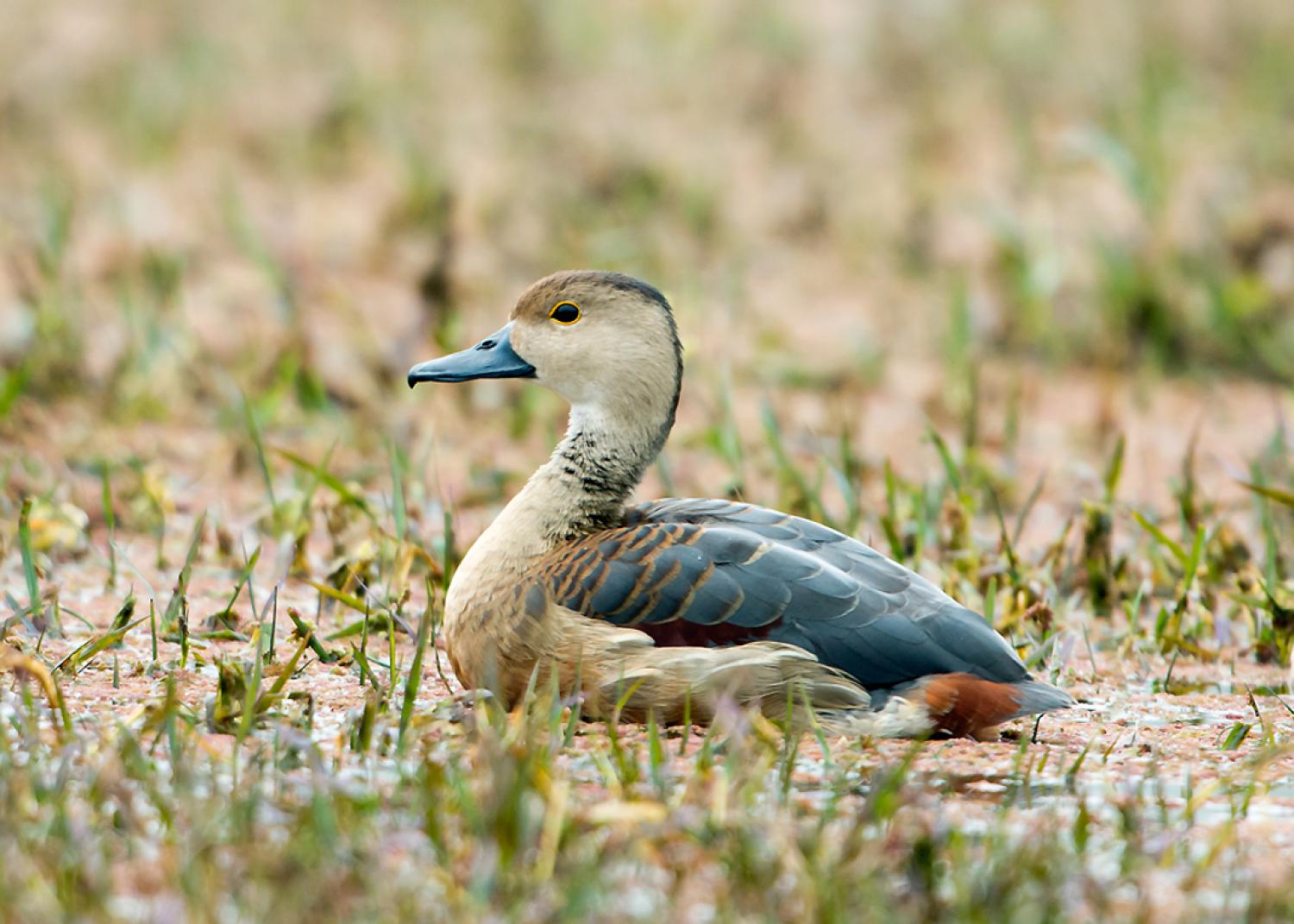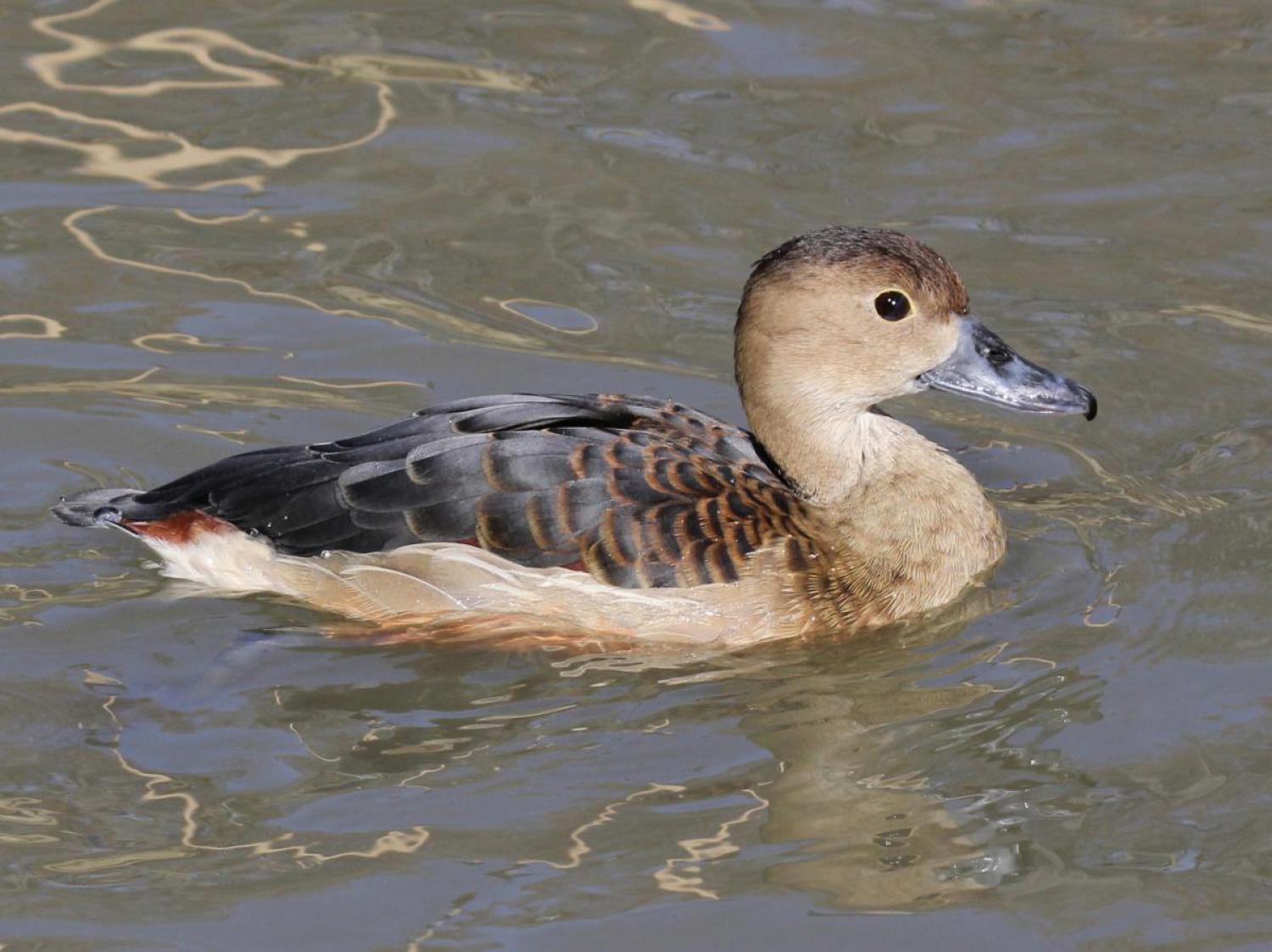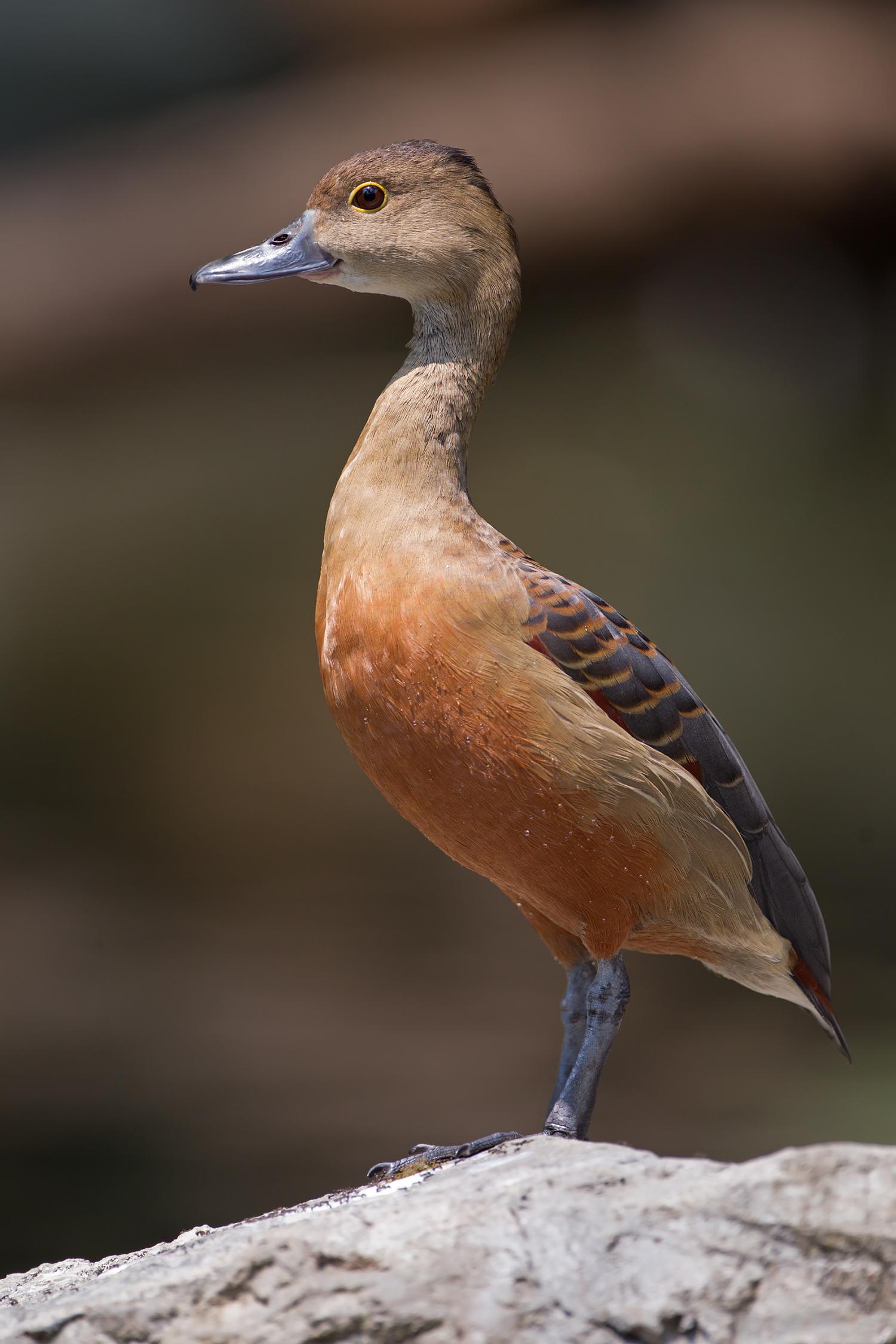Species of Thailand
Lesser whistling duck
Dendrocygna javanica
Thomas Horsfield, 1821
In Thai: เป็ดแดง
The lesser whistling duck (Dendrocygna javanica), also known as Indian whistling duck or lesser whistling teal, is a species of whistling duck that breeds in the Indian subcontinent and Southeast Asia. They are nocturnal feeders that during the day may be found in flocks around lakes and wet paddy fields. They can perch on trees and sometimes build their nest in the hollow of a tree. This brown and long-necked duck has broad wings that are visible in flight and produces a loud two-note wheezy call. It has a chestnut rump, differentiating it from its larger relative, the fulvous whistling duck, which has a creamy white rump.
Description
This chestnut brown duck is confusable only with the fulvous whistling duck (D. bicolor) but has chestnut upper-tail coverts unlike the creamy white in the latter. The ring around the eye is orange to yellow. When flying straight, their head is held below the level of the body as in other Dendrocygna species. The crown appears dark and the sexes are alike in plumage. They fly slowly but with rapid wing-flapping and usually produce a repetitive wheezy seasick call as they circle overhead. They are very nocturnal and often rest during the day. The outermost primary feather has the inner vane modified. They produce very prominent whistling sound while flying.
Distribution and habitat
This is a largely resident species distributed widely across lowland wetlands of the Indian subcontinent and Southeast Asia. The species also occur on islands in the region including the Andamans, Nicobars and Maldives. They sometimes make local movements in response to weather and changes in water availability and the more northern birds winter further south. They are found in freshwater wetlands with good vegetation cover and often rest during the day on the banks or even on the open sea in coastal areas. Downy chicks are black with a white eyebrow and white patches on the back of the head, the wing, lower back and rump. Albino individuals have been seen in the wild.
Large numbers are sometimes found in urban wetlands such as in Kolkata and Goa, particularly during winter. In the Alipore Zoological Gardens, captive individuals were introduced in the 1930s and wild birds joined this nucleus subsequently.
With a wide distribution range between 1 and 10 million km², they are considered to have a secure global population of between two and twenty million individuals. They are not threatened by hunting as they are not considered good to eat. Hunters in Assam however have been known to raise the ducklings to serve as live decoy.
Behaviour and ecology
Lesser whistling duck are usually gregarious. They feed mainly on plants taken from the water as well as grains from cultivated rice apart from small fish, frogs and invertebrates such as molluscs and worms. They dabble as well as dive in water. They will often waddle on the land and Common mynas have been noted to follow them on grass. Courtship involves the male facing the female and dipping and raising its bill in the water and swimming around the female. They breed during the monsoon or rainy season and may vary locally in relation to the food availability. The nest site may be a tree hole lined with twigs and grass or built in the fork of a large tree, sometimes reusing an old nest of a kite or heron or even on the ground. The clutch varies from 7 to 12 white eggs that are incubated by both the parents. Large clutches of up to 17 have been noted although these may be indications of intraspecific brood parasitism. The eggs hatch after about 22–24 days. More than one brood may be raised in a single season. Young birds may sometimes be carried on the back of the parents.
Local names like sili and silhahi in India are based on their wheezy two-note calls. They become very tame in captivity, walking about and responding to whistles. Individuals in captivity in the USA have lived for up to 9 years.
Several endoparasitic cestodes including Hymenolepis javanensis and Cittotaenia sandgroundi have been described from lesser whistling duck hosts apart from ectoparasitic bird lice and mites.
This article uses material from Wikipedia released under the Creative Commons Attribution-Share-Alike Licence 3.0. Eventual photos shown in this page may or may not be from Wikipedia, please see the license details for photos in photo by-lines.
Category / Seasonal Status
BCST Category: Recorded in an apparently wild state within the last 50 years
BCST Seasonal statuses:
- Resident or presumed resident
- Possibly non-breeding visitor
Scientific classification
- Kingdom
- Animalia
- Phylum
- Chordata
- Class
- Aves
- Order
- Anseriformes
- Family
- Anatidae
- Genus
- Dendrocygna
- Species
- Dendrocygna javanica
Common names
- Thai: เป็ดแดง
Conservation status

Least Concern (IUCN3.1)
Photos
Please help us review the bird photos if wrong ones are used. We can be reached via our contact us page.
Range Map

- Amphawa District, Samut Songkhram
- Ban Chang District, Rayong
- Ban Laem District, Phetchaburi
- Ban Lat District, Phetchaburi
- Ban Lueam District, Nakhon Ratchasima
- Ban Phai District, Khon Kaen
- Ban Sang District, Prachinburi
- Bang Ban District, Phra Nakhon Si Ayutthaya
- Bang Kruai District, Nonthaburi
- Bang Len District, Nakhon Pathom
- Bang Pa In District, Phra Nakhon Si Ayutthaya
- Bang Pahan District, Phra Nakhon Si Ayutthaya
- Bang Phra Non-Hunting Area
- Bang Pu Recreation Centre
- Bangkok Province
- Borabue District, Maha Sarakham
- Bueng Boraped Non-Hunting Area
- Bueng Khong Long Non-Hunting Area
- Buntharik District, Ubon Ratchathani
- Chae Hom District, Lampang
- Chaiyo District, Ang Thong
- Chatturat District, Chaiyaphum
- Chiang Dao District, Chiang Mai
- Chiang Dao Wildlife Sanctuary
- Chiang Khong District, Chiang Rai
- Chiang Saen District, Chiang Rai
- Doi Inthanon National Park
- Doi Lo District, Chiang Mai
- Doi Pha Hom Pok National Park
- Doi Saket District, Chiang Mai
- Doi Suthep - Pui National Park
- Don Chedi District, Suphan Buri
- Fang District, Chiang Mai
- Hang Chat District, Lampang
- Hat Yai District, Songkhla
- Huai Chorakhe Mak Reservoir Non-Hunting Area
- Huai Kha Khaeng Wildlife Sanctuary
- Huai Sala Wildlife Sanctuary
- Huai Talat Reservoir Non-Hunting Area
- Kabin Buri District, Prachinburi
- Kaeng Khoi District, Saraburi
- Kaeng Krachan District, Phetchaburi
- Kaeng Krachan National Park
- Kamphaeng Saen District, Nakhon Pathom
- Kanthararom District, Sisaket
- Kantharawichai District, Maha Sarakham
- Khao Ang Rue Nai Wildlife Sanctuary
- Khao Lak - Lam Ru National Park
- Khao Phra - Bang Khram Wildlife Sanctuary
- Khao Phra Wihan National Park
- Khao Sam Roi Yot National Park
- Khao Sok National Park
- Khao Yai National Park
- Khao Yoi District, Phetchaburi
- Khlong Luang District, Pathum Thani
- Khok Pho District, Pattani
- Khok Sung District, Sa Kaeo
- Khuan Khanun District, Phatthalung
- Khun Chae National Park
- Klaeng District, Rayong
- Ko Phra Thong
- Kui Buri National Park
- Kumphawapi District, Udon Thani
- Kut Thing Non-Hunting Area
- La-ngu District, Satun
- Laem Ngop District, Trat
- Laem Pak Bia
- Mae Ai District, Chiang Mai
- Mae Chan District, Chiang Rai
- Mae Mo District, Lampang
- Mae Rim District, Chiang Mai
- Mae Taeng District, Chiang Mai
- Mae Tha, Lampang District, Lampang
- Mu Ko Chumphon National Park
- Mueang Buriram District, Buriram
- Mueang Chachoengsao District, Chachoengsao
- Mueang Chan District, Sisaket
- Mueang Chiang Mai District, Chiang Mai
- Mueang Chiang Rai District, Chiang Rai
- Mueang Chonburi District, Chonburi
- Mueang Chumphon District, Chumphon
- Mueang Kalasin District, Kalasin
- Mueang Kanchanaburi District, Kanchanaburi
- Mueang Khon Kaen District, Khon Kaen
- Mueang Krabi District, Krabi
- Mueang Lampang District, Lampang
- Mueang Lamphun District, Lamphun
- Mueang Lopburi District, Lopburi
- Mueang Maha Sarakham District, Maha Sarakham
- Mueang Nakhon Nayok District, Nakhon Nayok
- Mueang Nakhon Pathom District, Nakhon Pathom
- Mueang Nakhon Ratchasima District, Nakhon Ratchasima
- Mueang Nakhon Si Thammarat District, Nakhon Si Thammarat
- Mueang Nan District, Nan
- Mueang Nong Khai District, Nong Khai
- Mueang Nonthaburi District, Nonthaburi
- Mueang Pathum Thani District, Pathum Thani
- Mueang Pattani District, Pattani
- Mueang Phang Nga District, Phang Nga
- Mueang Phayao District, Phayao
- Mueang Phetchaburi District, Phetchaburi
- Mueang Phichit District, Phichit
- Mueang Phitsanulok District, Phitsanulok
- Mueang Phuket District, Phuket
- Mueang Prachuap Khiri Khan District, Prachuap Khiri Khan
- Mueang Ratchaburi District, Ratchaburi
- Mueang Samut Sakhon District, Samut Sakhon
- Mueang Samut Songkhram District, Samut Songkhram
- Mueang Sisaket District, Sisaket
- Mueang Songkhla District, Songkhla
- Mueang Sukhothai District, Sukhothai
- Mueang Suphanburi District, Suphan Buri
- Mueang Surin District, Surin
- Mueang Tak District, Tak
- Mueang Udon Thani District, Udon Thani
- Mueang Uttaradit District, Uttaradit
- Na Chaluai District, Ubon Ratchathani
- Namtok Phlio National Park
- Non Thai District, Nakhon Ratchasima
- Nong Bong Khai Non-Hunting Area
- Nong Han Lake
- Nong Prue District, Kanchanaburi
- Nong Song Hong District, Khon Kaen
- Nong Suea District, Pathum Thani
- Nong Thung Thong Non-Hunting Area
- Nong Waeng Non-Hunting Area
- Nong Yai Area Development Project Under Royal Init
- Pa Sak Chonlasit Dam Non-Hunting Area
- Pa Sang District, Lamphun
- Pai District, Mae Hong Son
- Pak Chong District, Nakhon Ratchasima
- Pak Khat District, Bueng Kan
- Pak Kret District, Nonthaburi
- Pak Phanang District, Nakhon Si Thammarat
- Pak Phli District, Nakhon Nayok
- Pak Thale
- Pak Tho District, Ratchaburi
- Phanat Nikhom District, Chonburi
- Phatthana Nikhom District, Lopburi
- Phayuha Khiri District, Nakhon Sawan
- Phi Phi Islands
- Phimai District, Nakhon Ratchasima
- Phra Nakhon Si Ayutthaya District, Phra Nakhon Si Ayutthaya
- Phra Phrom District, Nakhon Si Thammarat
- Phu Khiao Wildlife Sanctuary
- Phutthamonthon District, Nakhon Pathom
- Pran Buri Forest Park
- Rattanaburi District, Surin
- Sai Noi District, Nonthaburi
- Sai Yok National Park
- Samut Prakan Province
- San Sai District, Chiang Mai
- Sanam Bin Reservoir Non-Hunting Area
- Sankhaburi District, Chainat
- Sathing Phra District, Songkhla
- Si Satchanalai District, Sukhothai
- Sikhoraphum District, Surin
- Takua Pa District, Phang Nga
- Taphan Hin District, Phichit
- Tha Sala District, Nakhon Si Thammarat
- Tha Takiap District, Chachoengsao
- Tha Yang District, Phetchaburi
- Thalang District, Phuket
- Thale Noi Non-Hunting Area
- Thanyaburi District, Pathum Thani
- Thap Lan National Park
- Thawat Buri District, Roi Et
- Thong Pha Phum District, Kanchanaburi
- Wang Chan District, Rayong
- Wang Nam Yen District, Sa Kaeo
- Wang Noi District, Phra Nakhon Si Ayutthaya
- Wat Phai Lom & Wat Ampu Wararam Non-Hunting Area
- Watthana Nakhon District, Sa Kaeo
- Yang Talat District, Kalasin


